Easy to make. Packed with protein. Bacon makes it better.
This post was originally published in 2015 and has become one of our most popular. It’s been updated here with new info and even more recipe-testing to make certain you get awesome results.
I’ve made Homemade Jerky lots of times; but as the saying goes, ‘Everything’s better with bacon.’ Turkey jerky is no exception.
The texture is great: chewy but not too tough to bite. Plus the little bits of bacon mixed in with the ground turkey make for a yummy-smokiness.
And it packs a powerful amount of protein – about 21 grams of protein per serving – compared to 13 grams/serving of a popular name-brand version.
Then there’s the cost comparison:
- My Homemade Bacon Turkey Jerky – $3.75 for 4-5 servings – about 20 pieces
- Name-brand turkey jerky – $8.25 for only 3 servings!
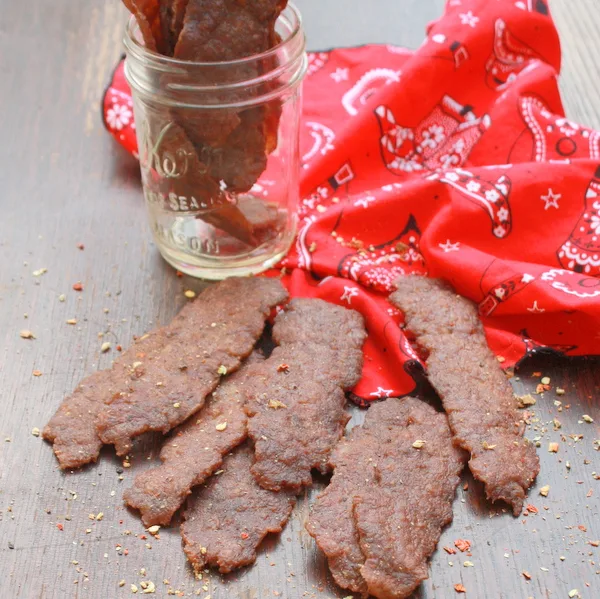
This recipe started with a text from Deanna: “Just tried TJ’s Bacon Jerky. Unbelievably good. I’ll bet you can make it.” And so the challenge was on to make a copycat version of Trader Joe’s Bacon Jerky. #TrueConfession – I didn’t get a chance to taste TJ’s version before it was unavailable – but this recipe won’t disappoint. Easy to make. Packed with protein. Bacon makes it better: Bacon Turkey Jerky via @tspcurry Click To Tweet
And it’s really fun to make! Here are some tips to making this protein-rich snack – the easy way:
- Use ground turkey – You may already have it on-hand and it’s not difficult to work with. Other recipes use whole cuts of slightly frozen meat and slice it super-thinly. This can get tedious.
- A zip-top plastic bag works instead of a jerky gun/press – While a jerky gun handily squeezes out jerky strips that are 1-inch wide and ¼-inch thick, I was pretty excited I got the same results using a plastic bag – with the corner snipped – and a rolling pin.
- No dehydrator needed – When making jerky in the oven, it must usually be cooked 8 hours in order to maintain food safety. So it can turn out crispy and tough. A dehydrator generally yields a better texture. But not everyone has a dehydrator. So my method of cooking at a higher temp, for a shorter time and then drying out additional moisture yields a safe and pleasantly pliable piece – without nitrates or preservatives.
- Hello bacon! I wanted the smoky, almost sweet flavor – and the wonderful fat that yields chewy not crispy jerky. But I didn’t want lots of extra fat – plus I knew too much fat would keep jerky from drying out properly. So I used a combo of finely chopped center-cut bacon and liquid smoke. (BTW, liquid smoke is not a weird combo of chemicals that produce a smoky flavor. It’s basically just water that’s collected after condensing over a smoking fire. Interestingly, it’s usually vegan.)
Now please tell me if you agree with my husband and kids: Isn’t everything – even jerky – better with bacon?
EQUIPMENT FOR HOMEMADE JERKY [affiliate links]:
Nordicware Natural Aluminum Commerical Baker’s Half Sheet
If You Care FSC Parchment Baking Paper
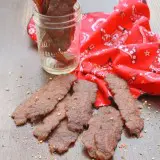
How To Make Bacon Turkey Jerky in the Oven
- Yield: About 20 pieces of jerky 1x
Description
Easy to make. Packed with protein. Bacon makes it better. You may even have ground turkey on-hand.
Ingredients
- 1 pound ground turkey (85% lean)
- 1 strip center-cut bacon, all white fat removed, minced very finely (about 1 tablespoon minced)
- 1 1/2 teaspoons liquid smoke
- 2 teaspoons Worcestershire sauce
- 1/2 teaspoon salt
- 1/2 teaspoon freshly ground pepper – about 10 grinds with the pepper mill
Instructions
- Cover 3 baking sheets with parchment paper. (For the trick to keep parchment paper from rolling up on you see this #HealthyKitchenHack)
- Combine all the ingredients in a large bowl; place into a gallon-sized zip-top plastic bag. With scissors, snip one bottom corner of the bag about 3/8-inch from the tip. Twist top of bag and pipe 5-inch strips of jerky meat onto prepared parchment paper. Fit about 9 strips on a sheet. If you have a rimmed baking sheet, just slide the parchment paper onto the counter and cover with another sheet of parchment paper. Using a rolling pin (or empty wine bottle,) carefully and evenly flatten the jerky to about 1/8-inch thick. Slide parchment paper back on baking sheet. (If you don’t have rimmed baking sheets, there’s no need to remove the parchment paper from baking sheet.)
- Preheat your oven to 160-degrees if you have a regular oven. Preheat to 195-degrees on a convection setting (so the oven automatically sets for 170-degrees). A convection oven is preferable for this recipe.
- Roast jerky for 2 hours; remove from oven and turn jerky pieces over. Replace baking sheets in different locations in oven (to allow for even roasting.) Check jerky after 30 minutes; it should be no longer pink – but pliable. It should only have a small amount of moisture/fat remaining on surface and should be nearly completely dry.
- Remove from oven and dry remaining moisture by pressing between paper towels and then placing on cooling rack to dry for 1 hour further (only if you have heat or air conditioner on – or live in a dry climate – a humid climate will only add moisture to jerky.)
- Store in refrigerator for 2 weeks – or longer in the freezer.
Have you ever made jerky? Do you own a food dehydrator?

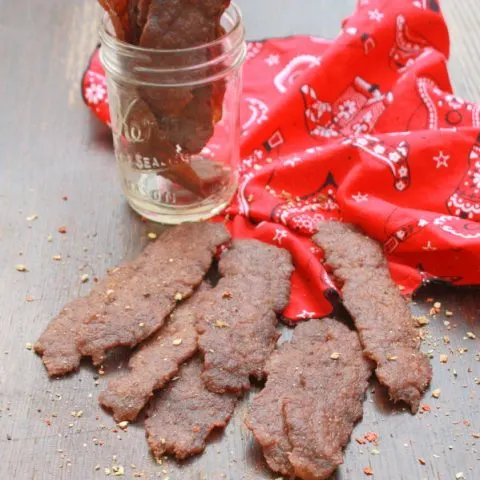

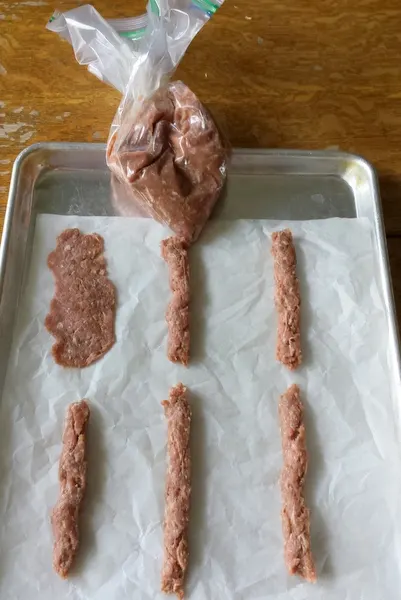
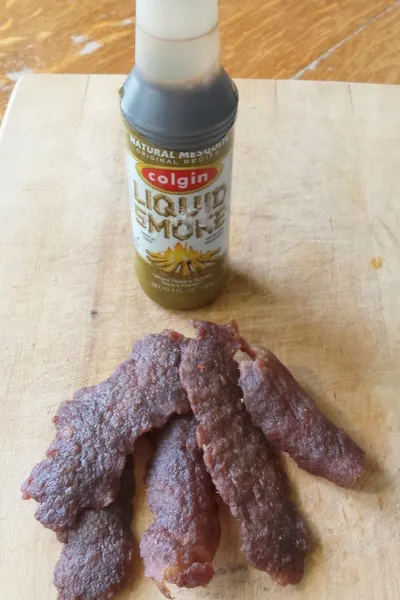

Jim Allen
Saturday 10th of March 2018
Thanks for the tips, Serena. A great idea to combine ground turkey with bacon. I may try a variation of this to make treats for my dog, and maybe some human treats along the way
Laura @ Sprint 2 the Table
Tuesday 13th of February 2018
You just won the prize for the coolest idea I've seen today. Totally trying this!
Serena Ball
Saturday 17th of February 2018
Wow. Thanks Laura. LMK when you try it. In fact, I think I need to make another batch, too...
Leon
Monday 26th of June 2017
anyone have a recipe using beef and what seasoning to make bacon or jerky
Serena Ball
Tuesday 27th of June 2017
Thanks asking Leon. Here's my recipe for Spicy Sweet Mole Jerky using venison or beef.
Susan
Tuesday 16th of May 2017
The idea of adding bacon is interesting, but is this just a simple way of adding the same flavors? Seems like it could all be turkey but, with the right care, have the same flavor profile.
Serena Ball
Tuesday 16th of May 2017
Try it! I'll bet you'll love the flavor profile, Susan! Thanks for visiting!
Kevin
Monday 23rd of May 2016
Didn't know that this is what liquid smoke is. Will have to check this out next time I see it.
Serena Ball
Friday 27th of May 2016
Thanks so much for stopping by Kevin! Yup, liquid smoke is the bomb. And surprisingly 'natural'!